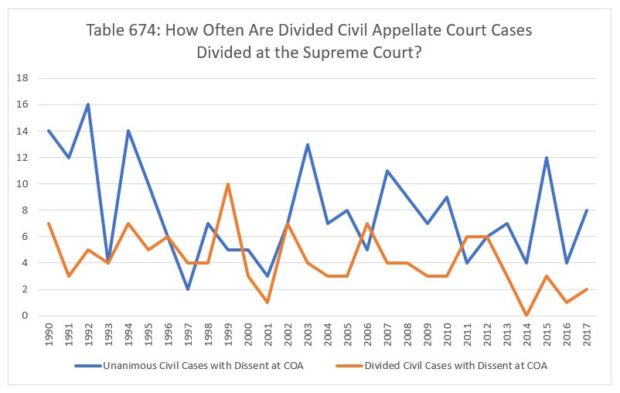
Yesterday, we tested whether publication at the Appellate Court has any impact on a civil case’s reversal rate at the Supreme Court. The answer is no – published Appellate Court decisions on the civil side are not consistently reversed at a higher or lower rate than unpublished decisions. Today, we test the same question on the criminal side.
On the criminal side, we see an interesting result. Between 1990 and 2003, published criminal decisions were reversed at a consistently higher rate than unpublished ones – published cases’ reversal rates were higher in thirteen of fourteen years. From 2004 to 2017, the relationship has nearly inverted. Of the fourteen years, published cases have had the higher reversal rate three times, the two sides have been tied in four years, and unpublished cases have had the higher reversal rate seven times.
In 1990, published criminal cases had a 51.61% reversal rate. Unpublished decisions were reversed at a 44.74% rate. In 1991, half the published cases were reversed, but only 13.33% of the unpublished decisions were. In 1992, 70.73% of the published decisions were reversed. Only 35.29% of the unpublished decisions were.
The reversal rate for unpublished criminal decisions stayed consistently low for another five years: 20% in 1993, 12.82% in 1994, 32.14% in 1995, 26.83% in 1996 and 29.27% in 1997. In each of these years except 1993, the reversal rate for published decisions was between fifty and sixty percent. The reversal rate for unpublished criminal decisions stayed below 50% from 1998 through 2003 (in fact, between 2000 and 2003, it was below 40%).
In 2004, one seat on the Court switched from Democratic to Republican. Beginning with that year, unpublished criminal decisions were reversed at a much higher rate, and the numbers for published and unpublished decisions became quite similar. In 2006, 44.44% of both published and unpublished decisions were reversed. In 2007, 61.54% of published cases and 69.23% of unpublished ones were reversed. In 2008, 47.83% of both published and unpublished decisions were reversed. In 2010, half of both published and unpublished decisions were reversed, and in 2011, both sides finished at 48% reversals.
Since 2012, there’s been no consistent relationship between the reversal rates on the published and unpublished sides. In 2012, 57.89% of published cases were reversed, and 35.71% of unpublished cases were. In 2013, 52.17% of published cases were reversed, but two-thirds of unpublished cases were. In 2014, 45.45% of published cases were reversed, and 27.27% of unpublished cases were. In 2015, 63.16% of published cases were reversed, but 78.57% of unpublished cases were. The numbers were similar in 2016 – 61.9% for published cases, 76.92% for unpublished cases. Last year, 45.45% of published cases were reversed, and 41.67% of unpublished cases were.

Join us back here next Tuesday as we turn our attention to another question.
Image courtesy of Flickr by Katherine Johnson (no changes).





























